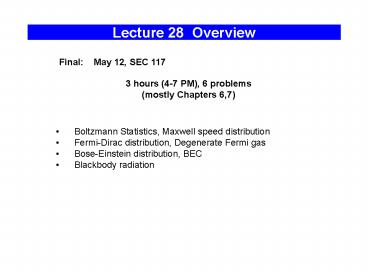Lecture 28 Overview - PowerPoint PPT Presentation
1 / 10
Title:
Lecture 28 Overview
Description:
Fermi-Dirac distribution, Degenerate Fermi gas. Bose-Einstein distribution, BEC ... Problem (degenerate Fermi gas) ... Fermi distribution (b) Calculate the ... – PowerPoint PPT presentation
Number of Views:89
Avg rating:3.0/5.0
Title: Lecture 28 Overview
1
Lecture 28 Overview
Final May 12, SEC 117
3 hours (4-7 PM), 6 problems (mostly Chapters 6,7)
- Boltzmann Statistics, Maxwell speed distribution
- Fermi-Dirac distribution, Degenerate Fermi gas
- Bose-Einstein distribution, BEC
- Blackbody radiation
2
Problem 1 (partition function, average energy)
The neutral carbon atom has a 9-fold degenerate
ground level and a 5-fold degenerate excited
level at an energy 0.82 eV above the ground
level. Spectroscopic measurements of a certain
star show that 10 of the neutral carbon atoms
are in the excited level, and that the population
of higher levels is negligible. Assuming thermal
equilibrium, find the temperature.
3
Problem 2006 (partition function, average energy)
Consider a system of N particles with only
3 possible energy levels separated by ? (let the
ground state energy be 0). The system occupies a
fixed volume V and is in thermal equilibrium with
a reservoir at temperature T. Ignore interactions
between particles and assume that Boltzmann
statistics applies. (a) (2) What is the
partition function for a single particle in the
system? (b) (5) What is the average energy per
particle? (c) (5) What is probability that the
2? level is occupied in the high temperature
limit, kBT gtgt ?? Explain your answer on
physical grounds. (d) (5) What is the average
energy per particle in the high temperature
limit, kBT gtgt ?? (e) (3) At what temperature is
the ground state 1.1 times as likely to be
occupied as the 2? level? (f) (25) Find the heat
capacity of the system, CV, analyze the low-T
(kBTltlt?) and high-T (kBT gtgt ?) limits, and sketch
CV as a function of T. Explain your answer on
physical grounds.
(a)
(b)
(c)
all 3 levels are populated with the same
probability
(d)
4
Problem 2006 (partition function, average energy)
(e)
(f)
Low T (?gtgt?)
high T (?ltlt?)
5
Problem (Boltzmann distribution)
- A solid is placed in an external magnetic field B
3 T. The solid contains weakly interacting
paramagnetic atoms of spin ½ so that the energy
of each atom is ? B, ? 9.310-23 J/T. - Below what temperature must one cool the solid so
that more than 75 percent of the atoms are
polarized with their spins parallel to the
external magnetic field? - An absorption of the radio-frequency
electromagnetic waves can induce transitions
between these two energy levels if the frequency
f satisfies he condition h f 2 ? B. The power
absorbed is proportional to the difference in the
number of atoms in these two energy states.
Assume that the solid is in thermal equilibrium
at ? B ltlt kBT. How does the absorbed power depend
on the temperature?
(a)
(b)
The absorbed power is proportional to the
difference in the number of atoms in these two
energy states
The absorbed power is inversely proportional to
the temperature.
6
Problem 2006 (maxwell-boltzmann)
(a) Find the temperature T at which the root mean
square thermal speed of a hydrogen molecule H2
exceeds its most probable speed by 400 m/s. (b)
The earths escape velocity (the velocity an
object must have at the sea level to escape the
earths gravitational field) is 7.9x103 m/s.
Compare this velocity with the root mean square
thermal velocity at 300K of (a) a nitrogen
molecule N2 and (b) a hydrogen molecule H2.
Explain why the earths atmosphere contains
nitrogen but not hydrogen.
Significant percentage of hydrogen molecules in
the tail of the Maxwell-Boltzmann distribution
can escape the gravitational field of the Earth.
7
Problem (degenerate Fermi gas)
The density of mobile electrons in copper is
8.51028 m-3, the effective mass the mass of a
free electron. (a) Estimate the magnitude of the
thermal de Broglie wavelength for an electron at
room temperature. Can you apply Boltzmann
statistics to this system? Explain.
- Fermi distribution
(b) Calculate the Fermi energy for mobile
electrons in Cu. Is room temperature sufficiently
low to treat this system as degenerate electron
gas? Explain.
- strongly degenerate
(c) If the copper is heated to 1160K, what is the
average number of electrons in the state with
energy ?F 0.1 eV?
8
Problem (photon gas)
9
Problem (BEC)
Consider a non-interacting gas of hydrogen atoms
(bosons) with the density of 1?1020m-3. a)(5)
Find the temperature of Bose-Einstein
condensation, TC, for this system. b)(5) Draw
aqualitative graph of the number of atoms as a
function of energy of the atoms for the cases T
gtgt TC and T 0.5 TC. If the total number of
atoms is 1?1020, how many atoms occupy the
ground state at T 0.5 TC? c)(5) Below TC, the
pressure in a degenerate Bose gas is proportional
to T5/2. Do you expect the temperature
dependence of pressure to be stronger or weaker
at T gt TC? Explain and draw aqualitative graph
of the temperature dependence of pressure over
the temperature range 0 ltT lt 2 TC.
10
Problem (BEC) (cont.)
- (c) The atoms in the ground state do not
contribute to pressure. At T lt TC, - two factors contribute to the fast increase of P
with temperature - an increase of the number of atoms in the excited
states, and - an increase of the average speed of atoms with
temperature. - Above TC, only the latter factor contributes to
P(T), and the rate of the pressure increase - with temperature becomes smaller than that at T lt
TC.































